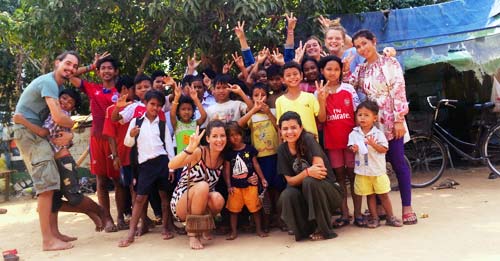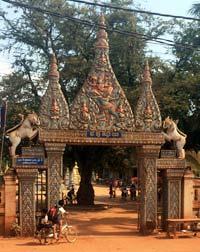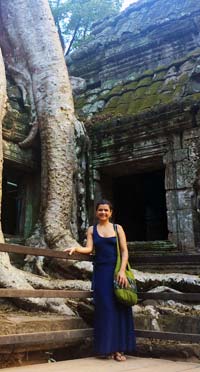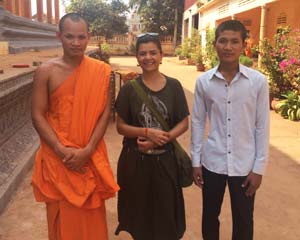Cláudia - Cambodia

Teaching English to Cambodian Monks
You don’t have to be a trained teacher to make an impact in a Cambodian classroom.
Take, for example, Cláudia, a travel industry professional from Portugal. She spent two weeks teaching English to Buddhist  monks in Siem Reap, the beautiful little city near the famous ancient Angkor Wat temples.
monks in Siem Reap, the beautiful little city near the famous ancient Angkor Wat temples.
“I visited Cambodia years ago, and always wanted to go back and spend more time in Siem Reap,” Cláudia explains.
Fluent in English, she knew that teaching the language at a pagoda school would be a unique way to gain valuable insight into this welcoming country and its gentle people.
As in many Asian nations, English is a valuable skill in Cambodia, and the nation’s thirst for instructors means there are many opportunities even for non-native speakers. Knowing the language well, and being a motivated teacher, is enough to make you welcomed.
This is especially true in Buddhist schools, local centers of education relied on by many impoverished families. But Buddhist schools aren’t just for the poor: most Cambodian children, even well-to-do youngsters, attend a Buddhist school for a year in this very Buddhist country.
Buddhist schools - particularly in the country - are usually quite modest, and can’t afford professional English teachers. That’s where volunteers come in - volunteering teachers are often the only English teachers these students will ever have. They play an important role and are very much appreciated.
In Siem Reap, Cláudia lived and dined at a local guest house, a cheerful and busy place where, she remembers, the food was very good. ELI’s in-country coordinators placed her two different settings, an orphanage and Buddhist schools. The orphanage served youngsters who couldn’t live with their parents due to poverty or issues related to alcohol and/or drug abuse.
 “They need affection and attention,” Cláudia says. “And learning English is very important to them. I would teach at the orphanage from 9 to 1, and then in the afternoons at two different Buddhist schools.”;
“They need affection and attention,” Cláudia says. “And learning English is very important to them. I would teach at the orphanage from 9 to 1, and then in the afternoons at two different Buddhist schools.”;
Initially told she’d be teaching little kids at the orphanage, Cláudia was surprised to discover most of her students were between 9 and 15 years old.
“I came prepared to teach shapes and colors, and had to quickly adjust my lesson ideas!” she laughs.
That was Cláudia’s own lesson number one: In Cambodia, it helps to be flexible. It also helps to purchase the students’ textbook.
“I noticed that the same book was used in many schools,” Cláudia says. “So I recommend volunteers buy it and use it for preparing the next day’s lesson. There’s no need to stress about creating your own lesson plan - just follow the textbook, and take it one day at a time.”
Cláudia did just that, and relied on drawing on the board, and the translations by the more advanced students, to teach her material.
“The students are smart and want to learn,” she says. “They catch on quickly.”
Cláudia taught two groups of Buddhist monks, one at a pagoda, and another at a different school. Her student monks were between 15 and 25 years old, and spoke little English; the second group also included older students and girls, and there was more of a variety of English level.
“You have to pay attention to the class, to see if the novices are learning, and sometimes you might have to ask someone more advanced to help translate.”
She characterizes the young monks as “very friendly and welcoming - but also shy.”
Cláudia was actually their first English teacher, adding to the students’ timidity.
She says she made an effort to first put them at ease, and then win their confidence. It worked: today, Cláudia keeps in touch with them via Facebook.
“They have another volunteer teacher now, so they’re happy to be keeping up their English studies.”
In the evenings, Cláudia would often relax in her guest house, or hit the lively restaurants and bars in Siem Reap. On weekends she’d explore the stunning temples of Angkor Wat, Cambodia’s biggest tourist attraction that draws thousands of travelers from around the world. Volunteers who stayed longer often used their weekends and holidays for daytrips to the nearby jungles and floating villages, or to Cambodia’s scenic mountains and beaches.
 If you’re interested in teaching English in Cambodia, go through an organized program, Cláudia advises. If possible, go with a friend or register with other volunteers.
If you’re interested in teaching English in Cambodia, go through an organized program, Cláudia advises. If possible, go with a friend or register with other volunteers.
“It’s a bit easier if you’re teaching with others.”
She recommends all women interested in teaching dress modestly.
“I wore longer skirts or very light pants, and shirts that covered the shoulders and cleavage.”
Dressing as a tourist, in shorts or tank tops, is not appropriate in a Cambodian work setting, a Buddhist school in particular. Cláudia recommends bringing few things with you, and buying what you need in Cambodia.
“There are a lot of shops in SIem Reap where you can buy very nice light clothes that aren’t expensive.”
Another option is to bring extra clothes with you that you could later leave for some in need.
Would Cláudia want to repeat her teaching experience in Cambodia?
“Yes,” she says without hesitation. “But I’d stay longer next time.”
Spoken like a true ELIer adventurer.
Interviews
- ARGENTINA - HIV
- BRAZIL - Wildlife
- BRAZIL - Wildlife
- CAMBODIA - Buddhist Monks
- CAMBODIA - Children
- CAMBODIA - Microfinance
- CHILE - Literature
- CHILE - Equine Therapy
- CHINA - Journalism
- CHINA - Urban Planning
- ECUADOR - Medical
- ECUADOR - Teaching
- ECUADOR - Physical Therapy
- ECUADOR - Veterinary
- ECUADOR - Youth
- GHANA - Orphanage
- GUATEMALA - Teaching
- INDIA - Women's Programs
- INDIA - Health & Youth
- INDIA - Journalism
- INDIA - Women's Empowerment
- IRELAND - Art Gallery
- IRELAND - Art
- IRELAND - Law
- IRELAND - Museums
- IRELAND - PR
- IRELAND - Veterinary I
- IRELAND - Veterinary II
- MEXICO - Youth
- NEPAL - Construction
- NEPAL - Orphanage
- NEPAL - Orphanage
- NEPAL - Veterinary
- NICARAGUA - Teaching
- NICARAGUA - Unwed Mother Support
- PERU - Teaching
- PHILIPPINES - Nutrition
- PHILIPPINES - Nutrition
- PORTUGAL - Fighting Food Waste
- PORTUGAL - Housing for the Poor
- SOUTH AFRICA - Public Health
- SOUTH AFRICA - Public Health
- SOUTH AFRICA - Engineering
- SOUTH AFRICA - Nutrition
- THAILAND - Elephant Camp
- THAILAND - Elephant & Medical
- THAILAND - Journalism
- THAILAND - Physical Therapy
- UGANDA - Medical
- UGANDA - Medical
- UGANDA - Medical
- UGANDA - Microfinance
- VIETNAM - Pharmacy
- VIETNAM - Women

